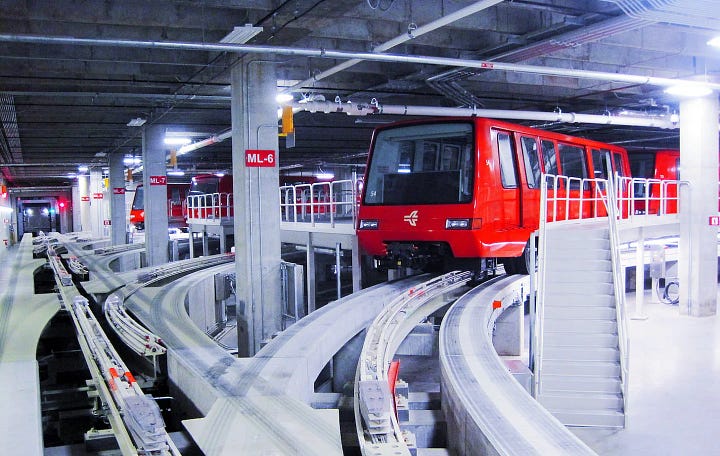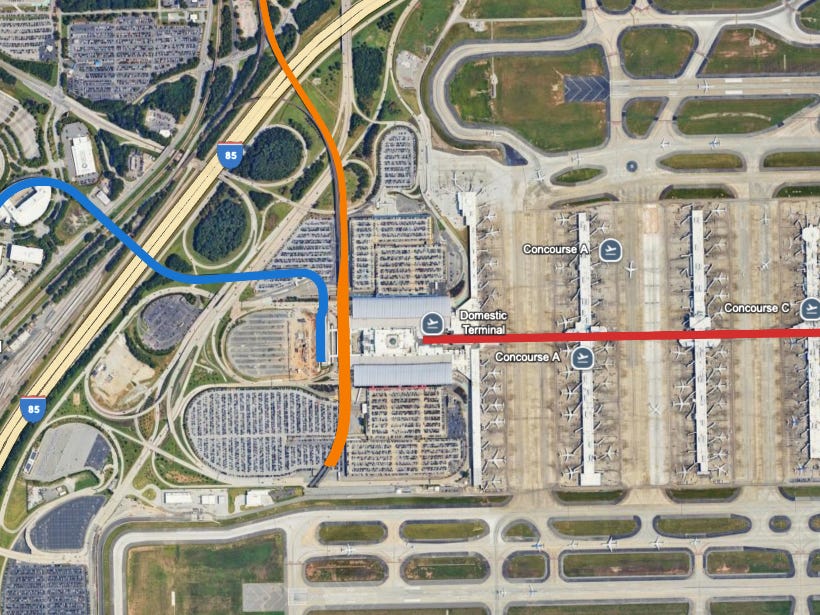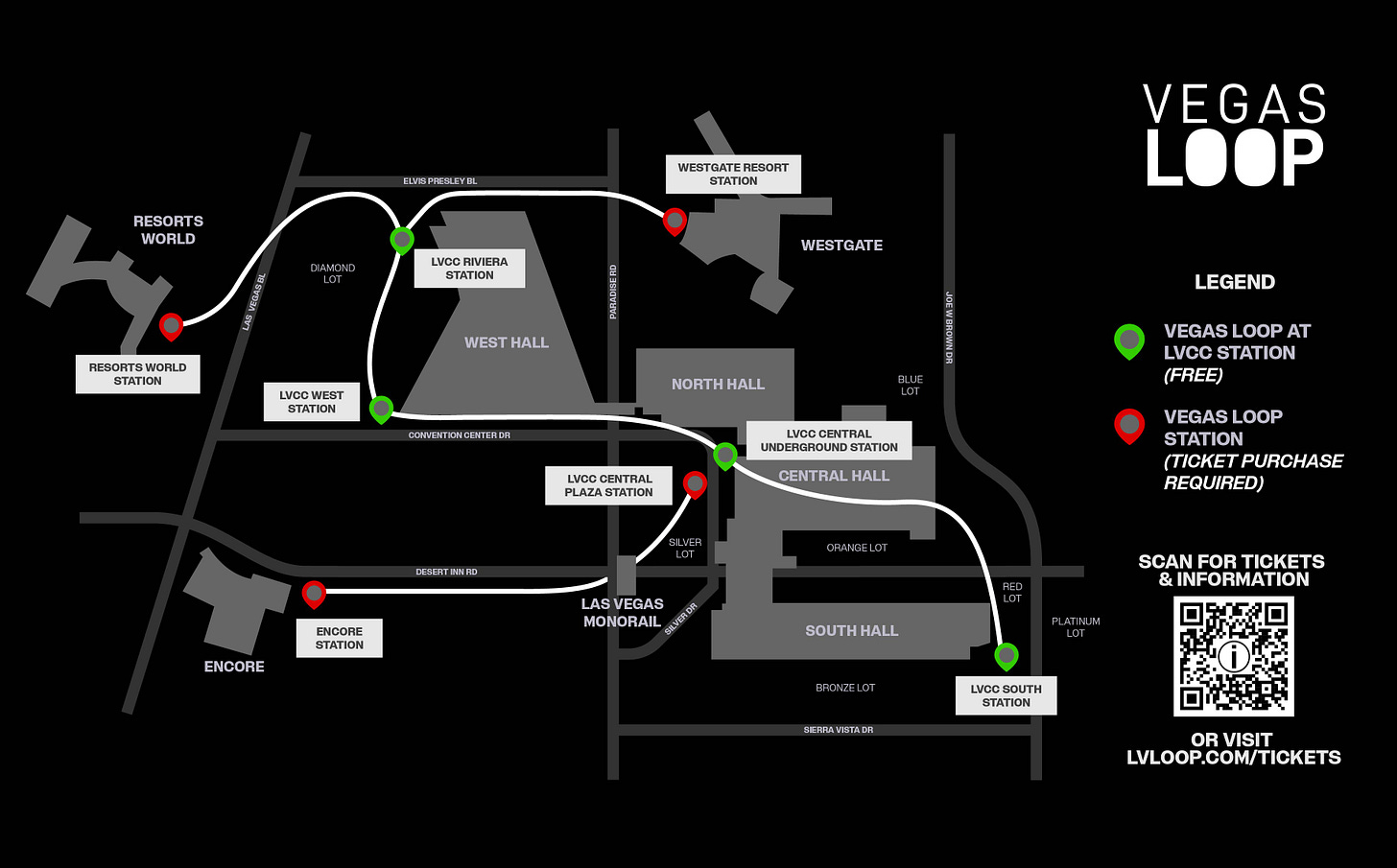The Busiest “Rail Line” You’ve Never Heard Of Is In the Suburbs of Atlanta
Atlanta’s 2.8-mile Plane Train quietly moves more people each day than most American transit systems, and might be the most efficient rail line in the Western Hemisphere.
Nearly every hour, around 230 planes land or take off from Atlanta’s Hartsfield-Jackson Airport, the busiest airport in the world. That’s not just because Atlanta’s a great place to visit; it’s Delta’s main hub, only a two-hour flight from 80% of the U.S. population, and a key connection point between North America, Latin America, and Europe.
But Hartsfield-Jackson isn’t just a marvel of air traffic; its terminal logistics are equally impressive, especially when it comes to connecting its seven island concourses.
To move passengers efficiently between them, Atlanta built the People Mover, better known as “The Plane Train.”
Planning for the Plane Train began in the 1970s, as the airport’s expansion plans evolved through multiple redesigns. The earlier AirTrain system at DFW, which ran in open trenches, struggled with weather issues, so Atlanta made a smarter call: build an underground, fully enclosed automated people mover.
The System:
Atlanta’s autonomous people mover system stretches 2.8 miles, serving eight stations with a single track in each direction, looping tightly at both ends.
The line operates with 11 four-car sets of the Innovia APM 100, an automated people mover first developed by Westinghouse, later by Bombardier, and now produced by Alstom. These trains are a global standard: you’ll find them in Houston, Denver, Las Vegas, Miami, Orlando, Pittsburgh, San Francisco, Seattle, Sacramento, and Tampa.
Next year, the Plane Train will see a fleet upgrade aimed at boosting both capacity and reliability, improvements to an already remarkably efficient system.


Now for the most impressive part: the Plane Train operates 20 hours a day, 365 days a year, and moves around 250,000 passengers daily. For comparison, MARTA, Atlanta’s entire rapid rail network (which connects directly to the airport), moves about 90,000 riders per day.
Here’s the kicker: 46 U.S. states have fewer total daily rail riders than this 2.8-mile airport train in suburban Atlanta.
To be clear, Texas, the second-largest state in the country, has fewer people riding rail each day than this short, underground people mover.
It’s a powerhouse
To put it another way: if the Atlanta Plane Train were its own transit agency, it would rank as the 11th largest in the country, just behind Disney World, based on my previous estimates.
This means cities like Miami, Denver, Portland, San Diego, and Las Vegas all see less transit ridership than Atlanta’s airport train.
Let that sink in: Dallas, the ninth-largest city in America, moves fewer people on its entire rail system than a 2.8-mile underground people mover in the suburbs of Atlanta.
What does that say about the state of U.S. transit? Maybe nothing. But it’s a fact I can’t shake.
Now, let’s put raw ridership aside and look at ridership per mile, the stat that really shows efficiency. The Plane Train moves about 89,285 riders per mile per day. For comparison, the New York City Subway (pre-Covid) carried roughly 22,152 riders per mile.
To the best of my research, there are only two transit lines in the world that move more people per mile:
Tokyo Metro Ginza Line — 106,000 riders/mile
Hong Kong Tsuen Wan Line — 109,000 riders/mile
That means Atlanta’s 11-train Plane Train, running under an airport, is the most efficient rail system in the Western Hemisphere.
People movers aren’t new, I’ll dig into them as urban transit systems in cities like Miami and Detroit in a future post. For now, let’s stick to the airport versions.
(And if you missed it, check out my Las Vegas people mover post from earlier this year, it pairs nicely with this post)
Definition of a People Mover
An airport people mover is a small, automated train system that shuttles passengers between terminals, gates, parking areas, and rental car centers. It’s designed to move huge numbers of people quickly and efficiently, without relying on buses or endless walking.
The United States has 23 airports with people movers, including Atlanta’s Plane Train and LAX’s soon-to-open system.
In larger airports, these systems come in two types:
Airside People Movers – Operate behind TSA security, connecting concourses and gates.
Landside People Movers – Connect the airport to parking areas, rental car centers, or nearby train stations.
Atlanta actually has both: the Plane Train, which runs airside, and the SkyTrain, which takes passengers landside to parking and the rental car center, completely separate from TSA.

And while the Plane Train shows that transit solves a geometry problem, moving more people through limited space, it also reveals just how absurd some “innovation” claims are.
Take the Boring Company’s Las Vegas Loop, for example. On paper, it’s basically a people mover, just with Teslas instead of trains. By their own documentation, to match the Plane Train’s throughput, they’d need 176 Teslas running continuously between concourses, and that’s not even accounting for luggage.
People movers are the unsung workhorses of public transit. Quietly, they’ve proven that automation and high-frequency work. They’re the clearest preview of what future urban rapid transit could (and should) look like: fast, frequent, reliable, and… automated.
Which airports and/or institutions would you like to see with a people mover?






